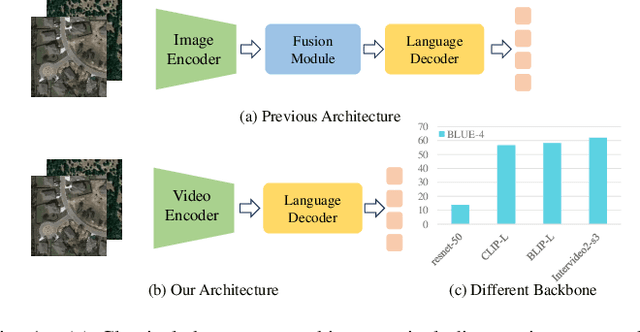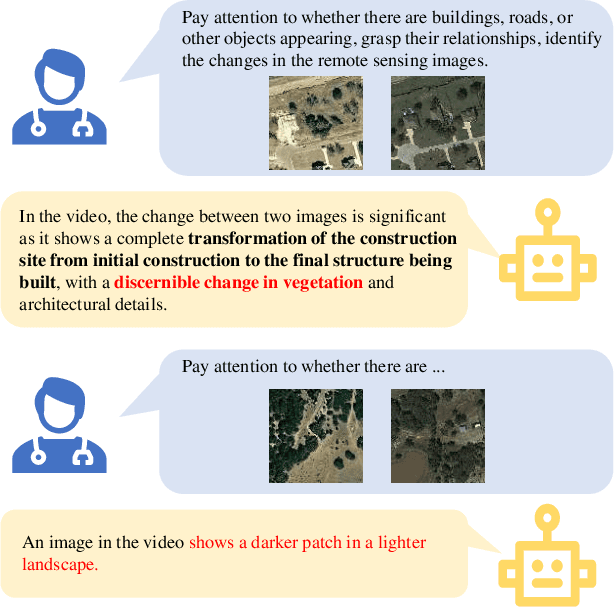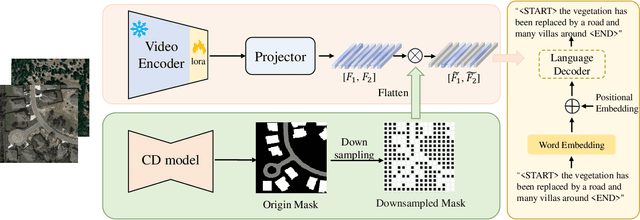Ruixun Liu
MV-CC: Mask Enhanced Video Model for Remote Sensing Change Caption
Oct 31, 2024



Abstract:Remote sensing image change caption (RSICC) aims to provide natural language descriptions for bi-temporal remote sensing images. Since Change Caption (CC) task requires both spatial and temporal features, previous works follow an encoder-fusion-decoder architecture. They use an image encoder to extract spatial features and the fusion module to integrate spatial features and extract temporal features, which leads to increasingly complex manual design of the fusion module. In this paper, we introduce a novel video model-based paradigm without design of the fusion module and propose a Mask-enhanced Video model for Change Caption (MV-CC). Specifically, we use the off-the-shelf video encoder to simultaneously extract the temporal and spatial features of bi-temporal images. Furthermore, the types of changes in the CC are set based on specific task requirements, and to enable the model to better focus on the regions of interest, we employ masks obtained from the Change Detection (CD) method to explicitly guide the CC model. Experimental results demonstrate that our proposed method can obtain better performance compared with other state-of-the-art RSICC methods. The code is available at https://github.com/liuruixun/MV-CC.
SegEarth-OV: Towards Traning-Free Open-Vocabulary Segmentation for Remote Sensing Images
Oct 02, 2024Abstract:Remote sensing image plays an irreplaceable role in fields such as agriculture, water resources, military, and disaster relief. Pixel-level interpretation is a critical aspect of remote sensing image applications; however, a prevalent limitation remains the need for extensive manual annotation. For this, we try to introduce open-vocabulary semantic segmentation (OVSS) into the remote sensing context. However, due to the sensitivity of remote sensing images to low-resolution features, distorted target shapes and ill-fitting boundaries are exhibited in the prediction mask. To tackle this issue, we propose a simple and general upsampler, SimFeatUp, to restore lost spatial information in deep features in a training-free style. Further, based on the observation of the abnormal response of local patch tokens to [CLS] token in CLIP, we propose to execute a straightforward subtraction operation to alleviate the global bias in patch tokens. Extensive experiments are conducted on 17 remote sensing datasets spanning semantic segmentation, building extraction, road detection, and flood detection tasks. Our method achieves an average of 5.8%, 8.2%, 4%, and 15.3% improvement over state-of-the-art methods on 4 tasks. All codes are released. \url{https://earth-insights.github.io/SegEarth-OV}
Rethinking the Graph Polynomial Filter via Positive and Negative Coupling Analysis
Apr 16, 2024Abstract:Recently, the optimization of polynomial filters within Spectral Graph Neural Networks (GNNs) has emerged as a prominent research focus. Existing spectral GNNs mainly emphasize polynomial properties in filter design, introducing computational overhead and neglecting the integration of crucial graph structure information. We argue that incorporating graph information into basis construction can enhance understanding of polynomial basis, and further facilitate simplified polynomial filter design. Motivated by this, we first propose a Positive and Negative Coupling Analysis (PNCA) framework, where the concepts of positive and negative activation are defined and their respective and mixed effects are analysed. Then, we explore PNCA from the message propagation perspective, revealing the subtle information hidden in the activation process. Subsequently, PNCA is used to analyze the mainstream polynomial filters, and a novel simple basis that decouples the positive and negative activation and fully utilizes graph structure information is designed. Finally, a simple GNN (called GSCNet) is proposed based on the new basis. Experimental results on the benchmark datasets for node classification verify that our GSCNet obtains better or comparable results compared with existing state-of-the-art GNNs while demanding relatively less computational time.
Class Similarity Transition: Decoupling Class Similarities and Imbalance from Generalized Few-shot Segmentation
Apr 08, 2024



Abstract:In Generalized Few-shot Segmentation (GFSS), a model is trained with a large corpus of base class samples and then adapted on limited samples of novel classes. This paper focuses on the relevance between base and novel classes, and improves GFSS in two aspects: 1) mining the similarity between base and novel classes to promote the learning of novel classes, and 2) mitigating the class imbalance issue caused by the volume difference between the support set and the training set. Specifically, we first propose a similarity transition matrix to guide the learning of novel classes with base class knowledge. Then, we leverage the Label-Distribution-Aware Margin (LDAM) loss and Transductive Inference to the GFSS task to address the problem of class imbalance as well as overfitting the support set. In addition, by extending the probability transition matrix, the proposed method can mitigate the catastrophic forgetting of base classes when learning novel classes. With a simple training phase, our proposed method can be applied to any segmentation network trained on base classes. We validated our methods on the adapted version of OpenEarthMap. Compared to existing GFSS baselines, our method excels them all from 3% to 7% and ranks second in the OpenEarthMap Land Cover Mapping Few-Shot Challenge at the completion of this paper. Code: https://github.com/earth-insights/ClassTrans
 Add to Chrome
Add to Chrome Add to Firefox
Add to Firefox Add to Edge
Add to Edge